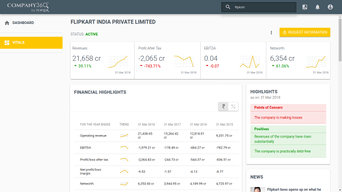Debt-to-equity ratio
What is the Debt-to-Equity Ratio?
The debt-to-Equity (D/E) ratio is used to assess a company’s financial standing. It is a measure of the relative contribution of shareholders and creditors in the capital employed in the business. In simple words, it is the ratio of the total long term debt and equity capital in the business.
The debt-to-equity ratio is an important metric and estimates the weight of financial obligations and the total debt against total shareholder’s equity. This ratio highlights how the capital structure of a company is titled either towards debt or equity financing. More specifically, the ratio reflects the ability of shareholder equity to cover all outstanding debts in case of a business downturn.
Key Highlights:
- D/E ratio is a financial ratio used to judge a company’s financial standing.
- While evaluating the health of a company, it is crucial to pay attention to the D/E ratio.
- If the ratio is high, it implies that the company is being funded by creditors rather than its own financial sources. Companies with high D/E ratios may not be able to attract additional lending capital.
How the Debt-to-Equity ratio is calculated?
There are two critical components used to evaluate the D/E ratio: shareholder’s equity and total liabilities. It can be found in the balance sheet of the company directly. This example will give you an idea about how to calculate the debt-to-equity ratio.
Let us consider a small business that owes ₹1, 25,360 to debtors and has ₹ 1, 11,205 in shareholder’s equity, then the debt-to-equity ratio is:
Debt to Equity Ratio = Total Debt / Shareholder's Equity
This formula is employed for debt-to-equity ratio calculation.
Debt to Equity Ratio = 1,25,360 / 1,11,205 =1.12
The ratio hints that the company is quite stable and has significant cash generation.
Let’s take another example of a company that has ₹12,00,00 of bank lines of credit and ₹15,00,000 mortgage on its property. If the shareholders have invested ₹37,00,000 in the company, then the D/E ratio would be
Debt to Equity Ratio = ₹(12,00,000+15,00,000) / ₹37,00,000 = 0.729
A D/E ratio equal to 1 indicates that the investors and creditors are on equal footing as far as the company assets are concerned. A D/E ratio greater than 1 which is, in this case, indicates a levered firm which is quite preferable.
How do companies use the debt-to-equity ratio?
This ratio is computed by investors and bankers to decide whether to lend money to a business or not. It helps them understand the ability of a company to generate revenue, cash flow, and profit to cover the expenses. It also assists senior management in making crucial financial decisions. It helps them gauge whether to approve taking on more debt for a proposed project or not. If the ratio is too high, then they would likely reject the proposal of securing loans.
It is essential for managers to understand how their work affects the debt-to-equity ratio. There are a lot of things that they do that can affect the ratio. How skillfully they manage the account, accounts receivable, cash flow, inventory, and more have an effect on the equation.
Debt-to-equity ratio interpretation:
The debt-to-equity ratio helps in analyzing the financial strategy of a company and helps one understand if the company is using debt financing or equity financing for running its operations. A high ratio is a sign of risk and means that the company is using more borrowing to finance its operations. A low ratio indicates that the company’s shareholder’s equity is in excess and it need not have to cap its debts to fund its operations and business. This also implies that the company has more owned capital than borrowed capital.
What is a good debt-to-equity ratio?
The debt-to-equity ratio varies from one industry to another. A good debt-to-equity ratio is anything less than 2.0. In some large establishments such as in fixed-asset heavy industries, the ratio may be greater than 2. Apart from this exception, the ratio greater than 2.0 indicates that the company derives 2/3rd of its capital financing from debt and the rest from shareholder equity. Its borrowing is twice as much funding as it owns. Here the management should aim for a debt load that is compatible with a favorable D/E ratio so that it can function without any worries about defaulting on its loans and bonds.
Significance of debt-to-equity ratio:
The debt-to-equity ratio is significant for the financial analysis of a company. Here are some reasons why it is extremely essential to consider it.
- The debt-to-equity ratio is a crucial assessment ratio utilized by potential investors to study the financial health of an organization. A high debt-to-equity ratio indicates low liquidity. It also implies that the company is unable to finance its obligations through the cash reserves and is dependent on the creditors. The probability of such entities to bankrupt is quite high.
- The debt-to-equity ratio helps in understanding the earnings of a shareholder. A high D/E ratio implies that the company is paying a high interest which is significantly cutting down its profits. A decrease in profit indicates a decrease in dividends paid to the ordinary shareholders.
- The ratio is utilized by creditors and lenders to understand the entity’s credit trustworthiness.
Wrapping up:
The debt-to-equity ratio is one of the most favored ratios in estimating the long-term financial stability of a company. It indicates the amount of debt and equity is used to finance a company’s assets. Creditors view a higher ratio as risky as it shows that the investors have not funded the operations as much as the creditors. The investors would not want to fund the business operations of a company not performing well. The debt-to-equity ratio formula is a crucial tool to judge the financial health of any company.
Company360 plans

Know more about your vendors, clients and competitors.
Financials, scores, ratios, excels, reports and more.
@ INR 9000/quarter